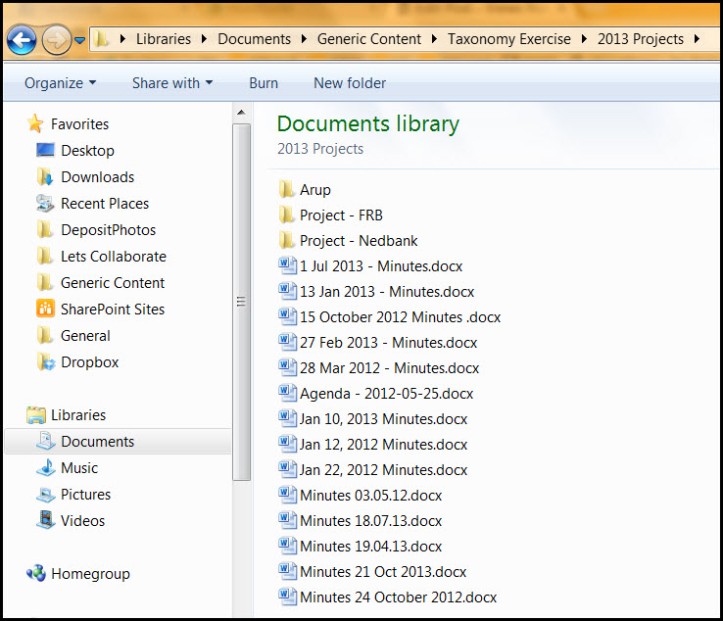Files are stored in alphabetical and numerical order from the left hand side in Microsoft products. Look at the order of the files and documents in this example. If you had to find the newest minutes, you would have to read through the whole list to find them.
But if you changed the date format to YYYY-MM-DD, it would be instantly obvious.
 And then in SharePoint you would be able to either change the filter to show newest to oldest.
And then in SharePoint you would be able to either change the filter to show newest to oldest.
 Or alternatively, change the view to sort the name in descending order.
Or alternatively, change the view to sort the name in descending order.
And then newest docs would always be on top. 🙂





[…] about naming standards – what date standard do you employ as it affects how you sort your documents after bulk uploading […]
LikeLike
[…] about naming standards – what date standard do you employ as it affects how you sort your documents after bulk uploading […]
LikeLike
[…] This article was originally posted here. […]
LikeLike
Hi Ken, thanks for the great tips. 🙂 Isn’t it crazy that we’ve got so many date formats on this planet. 😉
LikeLike
[…] Files are stored in alphabetical and numerical order from the left hand side in Microsoft products. Look at the order of the files and documents in this example. If you had to find the newest minutes, you would have to … Continue reading → Read More… […]
LikeLike
Hi Veronique,
Quite agree – this is a trick that I have been finding useful for years. It works in standard folder trees as well as SharePoint, and is particularly useful where you have lots of files with essentially the same name relating to different dates, e.g. meeting agendas or minutes, monthly / weekly reports, staff appraisals, etc.
Another useful trick for any “live” file that is updated frequently and doesn’t require a version history (e.g. Risks & Issues Logs) is to prefix the filename with a non-alphanumeric character (I use a tilde “~”) as this will bring it to the top of any alphanumeric listing.
Also, consider using the date format ddmmmyy or even ddmmmyyyy if there is the slightest chance that your documents will be used in both the USA and the UK, as it wastes time and is a potential source of error if people don’t know whether 07/01/13 means the 7th of January or the first of July. 07Jan2013 is utterly unambiguous and in its shortened form ddmmmyy is also more efficient on characters and visual space than dd/mm/yy or mm/dd/yy.
I enjoy your blog, keep up the good work!
Regards, Ken
LikeLike
[…] date format defaults to the American format and as I explained in the previous post, this is not always the most efficient way to sort […]
LikeLike